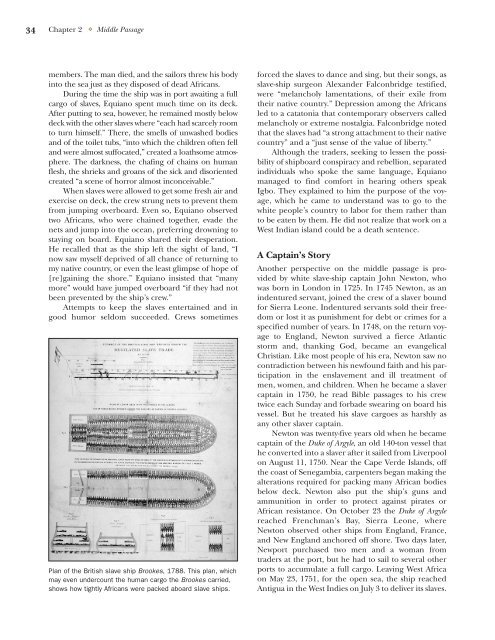You also want an ePaper? Increase the reach of your titles
YUMPU automatically turns print PDFs into web optimized ePapers that Google loves.
34 Chapter 2 <strong>Middle</strong> <strong>Passage</strong><br />
members. The man died, and the sailors threw his body<br />
into the sea just as they disposed of dead Africans.<br />
During the time the ship was in port awaiting a full<br />
cargo of slaves, Equiano spent much time on its deck.<br />
After putting to sea, however, he remained mostly below<br />
deck with the other slaves where “each had scarcely room<br />
to turn himself.” There, the smells of unwashed bodies<br />
and of the toilet tubs, “into which the children often fell<br />
and were almost suffocated,” created a loathsome atmosphere.<br />
The darkness, the chafing of chains on human<br />
flesh, the shrieks and groans of the sick and disoriented<br />
created “a scene of horror almost inconceivable.”<br />
When slaves were allowed to get some fresh air and<br />
exercise on deck, the crew strung nets to prevent them<br />
from jumping overboard. Even so, Equiano observed<br />
two Africans, who were chained together, evade the<br />
nets and jump into the ocean, preferring drowning to<br />
staying on board. Equiano shared their desperation.<br />
He recalled that as the ship left the sight of land, “I<br />
now saw myself deprived of all chance of returning to<br />
my native country, or even the least glimpse of hope of<br />
[re]gaining the shore.” Equiano insisted that “many<br />
more” would have jumped overboard “if they had not<br />
been prevented by the ship’s crew.”<br />
Attempts to keep the slaves entertained and in<br />
good humor seldom succeeded. Crews sometimes<br />
Plan of the British slave ship Brookes, 1788. This plan, which<br />
may even undercount the human cargo the Brookes carried,<br />
shows how tightly Africans were packed aboard slave ships.<br />
forced the slaves to dance and sing, but their songs, as<br />
slave-ship surgeon Alexander Falconbridge testified,<br />
were “melancholy lamentations, of their exile from<br />
their native country.” Depression among the Africans<br />
led to a catatonia that contemporary observers called<br />
melancholy or extreme nostalgia. Falconbridge noted<br />
that the slaves had “a strong attachment to their native<br />
country” and a “just sense of the value of liberty.”<br />
Although the traders, seeking to lessen the possibility<br />
of shipboard conspiracy and rebellion, separated<br />
individuals who spoke the same language, Equiano<br />
managed to find comfort in hearing others speak<br />
Igbo. They explained to him the purpose of the voyage,<br />
which he came to understand was to go to the<br />
white people’s country to labor for them rather than<br />
to be eaten by them. He did not realize that work on a<br />
West Indian island could be a death sentence.<br />
A Captain’s Story<br />
Another perspective on the middle passage is provided<br />
by white slave-ship captain John Newton, who<br />
was born in London in 1725. In 1745 Newton, as an<br />
indentured servant, joined the crew of a slaver bound<br />
for Sierra Leone. Indentured servants sold their freedom<br />
or lost it as punishment for debt or crimes for a<br />
specified number of years. In 1748, on the return voyage<br />
to England, Newton survived a fierce Atlantic<br />
storm and, thanking God, became an evangelical<br />
Christian. Like most people of his era, Newton saw no<br />
contradiction between his newfound faith and his participation<br />
in the enslavement and ill treatment of<br />
men, women, and children. When he became a slaver<br />
captain in 1750, he read Bible passages to his crew<br />
twice each Sunday and forbade swearing on board his<br />
vessel. But he treated his slave cargoes as harshly as<br />
any other slaver captain.<br />
Newton was twenty-five years old when he became<br />
captain of the Duke of Argyle, an old 140-ton vessel that<br />
he converted into a slaver after it sailed from Liverpool<br />
on August 11, 1750. Near the Cape Verde Islands, off<br />
the coast of Senegambia, carpenters began making the<br />
alterations required for packing many African bodies<br />
below deck. Newton also put the ship’s guns and<br />
ammunition in order to protect against pirates or<br />
African resistance. On October 23 the Duke of Argyle<br />
reached Frenchman’s Bay, Sierra Leone, where<br />
Newton observed other ships from England, France,<br />
and New England anchored off shore. Two days later,<br />
Newport purchased two men and a woman from<br />
traders at the port, but he had to sail to several other<br />
ports to accumulate a full cargo. Leaving West Africa<br />
on May 23, 1751, for the open sea, the ship reached<br />
Antigua in the West Indies on July 3 to deliver its slaves.

















